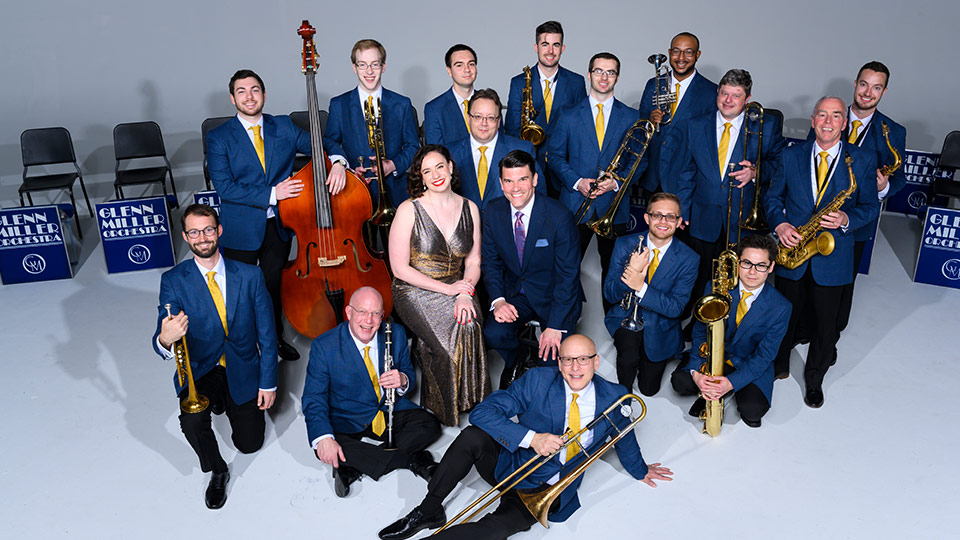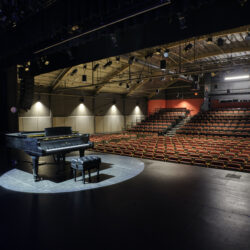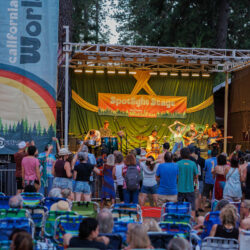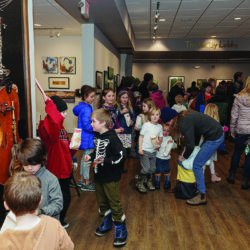The Glenn Miller Orchestra, the most popular and sought after big band in the world today for both concert and swing dance engagements, performs live on Wednesday, March 18, 2020 at the newly renovated Center for the Arts in Grass Valley. With its unique jazz sound, the Glenn Miller Orchestra is considered to be one of the greatest bands of all time.
Alton Glenn Miller got his musical start when, one day, his father brought home a mandolin. Glenn promptly traded it for an old battered horn, which he practiced every chance he got. In fact his mother worried, “It got to where Pop and I used to wonder if he’d ever amount to anything.” In 1923, Miller entered the University of Colorado. After flunking three of his five courses one semester, Glenn dropped out to concentrate on his career as a professional musician.
He toured with several orchestras and ended up in Los Angeles where he landed a spot in Ben Pollack’s group, a band that included a guy named Benny Goodman. Here, Miller also got the chance to write some arrangements. Miller played and recorded with the likes of Tommy and Jimmy Dorsey, Gene Krupa, Eddie Condon and Coleman Hawkins. Miller became the musical director of the Dorsey Band, and later went on to organize The Ray Noble Orchestra.
In April 1935, Glenn Miller recorded, for the first time, under his own name. Using six horns, a rhythm section and a string quartet, he recorded “Moonlight on the Ganges” and “A Blues Serenade” for Columbia. But selling only a few hundred records, he continued his position with the Noble Orchestra.
In 1937, Glenn Miller stepped out to form his own band. There were a few recordings — one for Decca and one for Brunswick — a couple of week-long stints in New Orleans and Dallas, and many one-nighters, but it was not to be. Though the group would play one more date several days later in Bridgeport, Connecticut, Glenn gave his men their final notice on New Year’s Eve at the Valencia Ballroom in York, Pennsylvania. Broke, depressed and having no idea what he was going to do, he returned to New York City.
It is said that Miller could never remember precisely the moment he decided to emphasize his new reed section sound. But it was during this disheartening interim, that he realized the unique sound — produced by the clarinet holding the melodic line while the tenor sax plays the same note, and supported harmonically by three other saxophones — just might be the individual and easily recognizable style that would set his band apart from all the rest.
“A band ought to have a sound all of its own. It ought to have a personality.” – Glenn Miller
Formed in March 1938, the second Glenn Miller Orchestra soon began breaking attendance records all up and down the East Coast. At the New York State Fair in Syracuse it attracted the largest dancing crowd in the city’s history. The next night it topped Guy Lombardo’s all-time record at the Hershey Park Ballroom in Pennsylvania. The Orchestra was invited by ASCAP to perform at Carnegie Hall with three of the greatest bands ever — Paul Whiteman, Fred Waring and Benny Goodman — and created more of a stir than any of them.
There were record-breaking recordings, as well, such as “Tuxedo Junction”, which sold 115,000 copies in the first week. In 1941, it was off to Hollywood where the band worked on its first movie, “Sun Valley Serenade”, which introduced the song — and soon-to-be million selling record –”Chattanooga Choo Choo”, and featured the Modernaires and the Nicholas Brothers. Then came “Orchestra Wives”. But the war was starting to take its toll on many of the big bands as musicians, and the rest of the country’s young men, began receiving draft notices.
On October 7, 1942, Alton Glenn Miller reported for induction into the Army and was immediately assigned to the Army Specialist Corps. His appointment as a Captain came after many months of convincing the military higher-ups that he could modernize the army band and ultimately improve the morale of the men. His training complete, he was transferred into the Army Air Corps, where he ultimately organized the Glenn Miller Army Air Force Band. Miller’s goal of entertaining the fighting troops took another year to be realized, but in late 1943 he and the band were shipped out to England.
There, in less than one year, the Glenn Miller Army Air Force Band engaged in over 800 performances. Of these, 500 were broadcasts heard by millions. There were more than 300 personal appearances including concerts and dances. But Glenn was not to participate in the final six months of these activities.
In the Fall of 1944, the band was scheduled to be sent on a six-week tour of Europe and would be stationed in Paris during that time. Miller decided to go ahead, in order to make the proper arrangements for the group’s arrival. And so, on December 15th, Glenn Miller boarded a transport plane to Paris, never to be seen again.
The present Glenn Miller Orchestra was formed in 1956 and has been touring consistently since, playing an average of 300 live dates a year all around the world. Experience The World Famous Glenn Miller Orchestra on Wednesday, March 18, 2020 at The Center for the Arts, 314 W. Main Street, downtown Grass Valley. Doors open at 6:30 for the 7:30 performance. Tickets available at thecenterforthearts.org, at Briarpatch Co-op, and at the temporary box office located at 128 E Main Street in the Grass Valley Chamber of Commerce.




